† Corresponding author. E-mail:
In this paper, new exact solutions of the time fractional KdV–Khokhlov–Zabolotskaya–Kuznetsov (KdV–KZK) equation are obtained by the classical Kudryashov method and modified Kudryashov method respectively. For this purpose, the modified Riemann–Liouville derivative is used to convert the nonlinear time fractional KdV–KZK equation into the nonlinear ordinary differential equation. In the present analysis, the classical Kudryashov method and modified Kudryashov method are both used successively to compute the analytical solutions of the time fractional KdV–KZK equation. As a result, new exact solutions involving the symmetrical Fibonacci function, hyperbolic function and exponential function are obtained for the first time. The methods under consideration are reliable and efficient, and can be used as an alternative to establish new exact solutions of different types of fractional differential equations arising from mathematical physics. The obtained results are exhibited graphically in order to demonstrate the efficiencies and applicabilities of these proposed methods of solving the nonlinear time fractional KdV–KZK equation.
In recent years, fractional calculus has played a very important role in various application areas, such as modeling anomalous diffusion, heat transfer, seismic wave analysis, signal processing, control theory, image processing, and many other fractional dynamical systems.[1–6] Fractional differential equations (FDEs) are the generalized form of classical differential equations of integer order. The FDEs are inherently multi-disciplinary with their application across diverse disciplines of applied science and engineering. Recently, FDEs have attracted great attention due to their applications in various real physical problems. The properties of several physical phenomena are found to be best described by FDEs. For this purpose, a reliable and efficient technique is essential for solving the nonlinear FDEs. In this connection, it is worthwhile to mention the recent notable studies of the solutions of FDEs, integral equations and fractional partial differential equations (FPDEs) of physical interest. Several analytical and numerical methods have been employed to develop approximate and exact solutions of FDEs.[7–18]
The sound propagation in fluid is determined by nonlinearity, diffraction, absorption and dispersion. For modelling the nonlinear sound propagation in fluid, the combined effects of nonlinearity, absorption, dispersion and diffraction should be taken into account. The description of sound propagation in fluid requires accurate representations of nonlinearity, dispersion, absorption, and diffraction. The KdV–Khokhlov–Zabolotskaya–Kuznetsov (KdV–KZK) equation describes all the basic physical mechanisms of sound propagation in fluids.[19]
Now we consider the (3+1)-dimensional time fractional KdV–KZK equation:



The first term on the right-hand side of Eq. (

The KdV–KZK equation for fluids has profound applications in aerodynamics and acoustics, and also its extension to solids has applications in biomedical engineering and in nonlinear acoustical nondestructive testing.
Nonlinear FDEs can be transformed into integer-order nonlinear ordinary differential equations via fractional complex transform with the help of the modified Riemann–Liouville fractional derivative and corresponding useful formulae. The present methods[20–25] under study can be devised to develop the exact analytical solutions for the time fractional KdV–KZK equation. The main motivation of this paper is to develop the exact solutions of the fractional order KdV–KZK equation. To the best of the author’s knowledge, the exact analytical solutions for the fractional KdV–KZK equation have been reported for the first time in this paper.
The rest of this paper is organized as follows. In Section 2, some definitions and corresponding properties of the modified Riemann–Liouville derivative are described. In Section 3, the description of the algorithm for solving FPDEs by using both the classical Kudryashov method and modified Kudryashov method via fractional complex transform is presented. Then in Section 4, these methods have been implemented to establish new exact solutions for the time fractional KdV–KZK equation. Next, in Section 5, the numerical simulations for the nonlinear time fractional KdV–KZK equation are discussed. In Section 6, some conclusions are drawn from the present studies.
The modified Riemann–Liouville derivative[26–29] of order α is given as follows:






In this section, an algorithm is presented for the analytical solutions of Eq. (





By using the chain rule, we have

Thus, the FPDE (


for the classical Kudryashov method


for the modified Kudryashov method





In the present section, the new exact analytical solutions of the time fractional KdV–KZK equation are obtained for the first time by using the Kudryashov method and modified Kudryashov method respectively.
In the present analysis, we introduce the following fractional complex transform into Eq. (

By applying the fractional complex transform (


The dominant terms with the highest order of singularity are γ λ 4U‴(ξ) and 2A2 λ2U(ξ)U′(ξ). Thus the pole order of Eq. (
Therefore, the solution that we seek is in the following form:

Substituting the derivatives of function U(ξ) with respect to ξ and taking into account the ansatz (
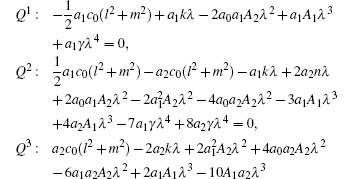

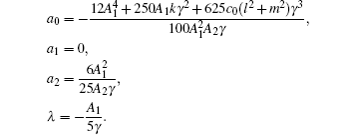

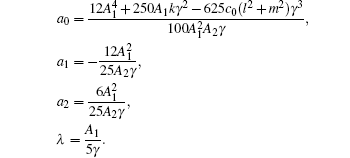

Following the same preceding argument, equation (

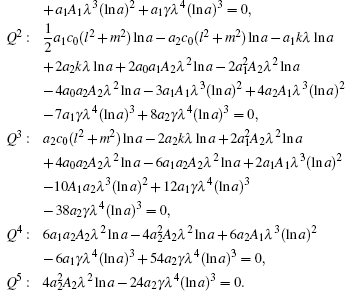
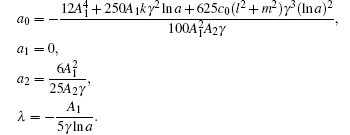


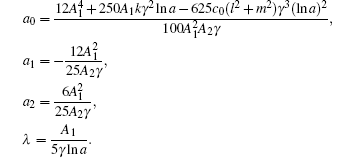


In this section, the numerical simulations of the time-fractional KdV–KZK equation are presented graphically. Here the exact solutions (
In the present analysis, equations ( Solitary wave solutions for Eq. ( Solitary wave solutions for Eq. (
In the present analysis, equations (
In the present numerical simulations, the solitary wave solutions for Eqs. ( Solitary wave solutions for Eq. ( Solitary wave solutions for Eq. ( Solitary wave solutions for Eq. ( Solitary wave solutions for Eq. (
The KdV–KZK equation covers all the four basic physical mechanisms of nonlinear acoustics, viz. diffraction, nonlinearity, dissipation and dispersion. The solution of the KdV–KZK equation describes a shock wave as a transition between two constant velocity values. This transition can undergo oscillations due to the dispersion.
The obtained results are related to physical phenomenon in Cantorian time-space. These results enrich the properties of the genuinely nonlinear phenomenon. To the best of the author’s knowledge, the obtained solutions in this paper have not been reported in the literature. The reported results have a potential application in observing the structure of the KdV–KZK equation from micro-physical to macro-physical behavior of substances in the real world.
In this paper, the new exact solutions of the time fractional KdV–KZK equation are obtained by the classical Kudryashov and modified Kudryashov method respectively with the help of the fractional complex transform. The fractional complex transform is employed in order to convert an FDE into its equivalent ODE form. So, the fractional complex transform facilitates solving FDEs. Two methods are successfully used to solve the nonlinear time fractional KdV–KZK equation. The new obtained exact solutions may be useful for explaining some physical phenomena accurately. The present analysis indicates that the methods discussed in this paper are effective and efficient for analytically solving the time fractional KdV–KZK equation. It also demonstrates that the performances of these methods are substantially influential and absolutely reliable for finding new exact solutions in terms of symmetrical hyperbolic Fibonacci function solutions. In the present analysis, the discussed methods clearly avoid linearization, discretization, and unrealistic assumptions and therefore these methods provide exact solutions efficiently and accurately. To the best of the author’s knowledge, new exact analytical solutions of the time fractional KdV–KZK equation are obtained for the first time in this respect.
| 1 | |
| 2 | |
| 3 | |
| 4 | |
| 5 | |
| 6 | |
| 7 | |
| 8 | |
| 9 | |
| 10 | |
| 11 | |
| 12 | |
| 13 | |
| 14 | |
| 15 | |
| 16 | |
| 17 | |
| 18 | |
| 19 | |
| 20 | |
| 21 | |
| 22 | |
| 23 | |
| 24 | |
| 25 | |
| 26 | |
| 27 | |
| 28 | |
| 29 | |
| 30 | |
| 31 | |
| 32 | |
| 33 | |
| 34 | |
| 35 |


